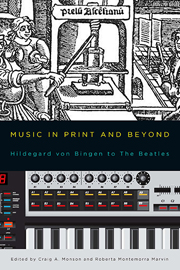Book contents
- Frontmatter
- Dedication
- Contents
- Acknowledgments
- Introduction
- 1 Robert Granjon and Music during the Golden Age of Typography
- 2 Publishing Music Theory in Early Cinquecento Venice and Bologna: Friends and Foes
- 3 Preaching to the Choir: Arts of Persuasion in the Converts of Italy
- 4 Music Distribution in London during Handel's Lifetime: Manuscript Copies versus Prints
- 5 Beethoven's Miniatures
- 6 “The Beautiful and the Ugly”: Travel Literature, Racial Theory, and a Schumann Song
- 7 Verdi's “Music of the Future”
- 8 The Suspended Voice of Amália Rodrigues
- 9 More than Mostly Mozart: Teddy Wilson's “China Boy”
- 10 Wanted Dead and Alive: Historical Performance Practice and Electro-Acoustic Music from IRCAM to Abbey Road
- 11 Lowinsky's Secrets
- 12 The Unknown Hildegard: Editing, Performance, and Reception (An Ordo Virtutum in Five Acts)
- List of Contributors
- Index
Introduction
Published online by Cambridge University Press: 05 March 2014
- Frontmatter
- Dedication
- Contents
- Acknowledgments
- Introduction
- 1 Robert Granjon and Music during the Golden Age of Typography
- 2 Publishing Music Theory in Early Cinquecento Venice and Bologna: Friends and Foes
- 3 Preaching to the Choir: Arts of Persuasion in the Converts of Italy
- 4 Music Distribution in London during Handel's Lifetime: Manuscript Copies versus Prints
- 5 Beethoven's Miniatures
- 6 “The Beautiful and the Ugly”: Travel Literature, Racial Theory, and a Schumann Song
- 7 Verdi's “Music of the Future”
- 8 The Suspended Voice of Amália Rodrigues
- 9 More than Mostly Mozart: Teddy Wilson's “China Boy”
- 10 Wanted Dead and Alive: Historical Performance Practice and Electro-Acoustic Music from IRCAM to Abbey Road
- 11 Lowinsky's Secrets
- 12 The Unknown Hildegard: Editing, Performance, and Reception (An Ordo Virtutum in Five Acts)
- List of Contributors
- Index
Summary
The dissemination of music and of ideas about music preoccupied humanists long before the emergence of musicology as an academic specialty. How music has reached performers and listeners, the means of musical distribution, both in manuscript and in print; the modes through which creators, executants, and their critics have communicated; the methods and purposes of musical appropriation through the ages—all form the foundation and objects of musicological investigation.
Musicologists were investigating music's dissemination in print long before sixteenth-century printers caught the great tsunami of Renaissance musicology as it crested in the late 1960s and early 1970s. As disciplinary perspectives broadened beyond composers' biographies and editions of their works, several American scholars turned their attention to the printers who, after the familiar Ottaviano Petrucci, made much of that music available. By the 1970s, “publish or perish” even determined early modern composers’ inclusion in The New Grove Dictionary of Music: where all medieval composers secured a place in the dictionary, the only High Renaissance composers included were those whose works had found their way into print in their day. Musicological research extended to wider aspects of the printing phenomenon and its influences, what we have come to call “print culture.” Having expanded from sixteenth-century Italy to France and the Netherlands, musicological discussion of printing further fanned out chronologically and geographically to encompass the wider field of Western musical culture, and beyond the printed note to other forms of print culture that have mediated musical composition, theory, performance, and reception.
- Type
- Chapter
- Information
- Music in Print and BeyondHildegard von Bingen to The Beatles, pp. 1 - 10Publisher: Boydell & BrewerPrint publication year: 2013

